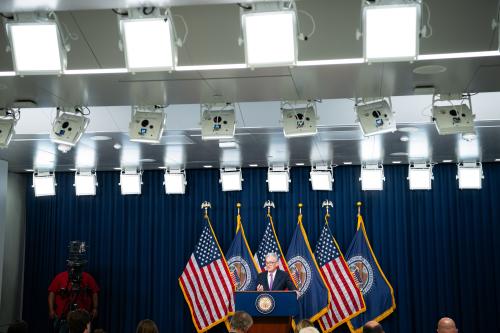The U.S. unemployment has fallen and the U.S. economy appears to be on track to grow faster than its potential growth rate of around 2%. So why isn’t the Federal Reserve moving more quickly to raise short-term interest rates, which have been at zero since late 2008? Why is it still resolved to be “patient in beginning to normalize the stance of monetary policy.”
In remarks delivered in Singapore, Donald Kohn, Robert S. Kerry Senior Fellow in the Economic Studies program at Brookings and a former vice chair of the Federal Reserve Board, offered a simple answer: Inflation. There isn’t any.
“There are signs that underlying inflation rates have not been moving toward the two percent target, certainly not as quickly as might be expected given the approach of the unemployment rate and capacity utilization towards levels that in the past had been associated with reasonably full employment,” Kohn said.
And why is that? “One possibility is that the unemployment rate we usually look at isn’t representative of the true state of the labor market. Workers who have dropped out of the labor force in this long slow recovery or who have taken part time jobs when they wanted full time jobs are available and ready to work and are a potential source of labor supply, even though they don’t count in the usual unemployment rate. In effect, the sustainable unemployment rate might be lower than we thought—at least for a while. The data on wages and labor costs are quite mixed; some measures show the sort of pick up you’d expect as the unemployment rate has dropped to relatively low levels, but others remain very weak. The Fed will be monitoring labor costs carefully to judge just how close to full employment the US is,” he said.
“Another possibility is that these drops in energy and import prices are—or might—feed through to underlying inflation on a more persistent basis through second-round effects. A key channel for this type of effect would be through inflation expectations—not so much through the expectations of inflation in the near-term, which we know will be held down by energy price declines, but by expectations about inflation once the energy price decline has passed through the system. If people come to expect very low inflation over a long period, they will adjust wages and prices accordingly in a self-fulfilling feedback. The evidence here also is mixed,” Kohn said.
It’ll take the Fed “some months” to sort through the evidence on inflation, Kohn said. “That’s why most observers don’t expect it to raise rates before midyear, and possibly for several months thereafter. When it does finally raise rates, it will want to be fairly confident it is the right thing to do.”
In his remarks, Kohn also sketched out the possible effects of the slowing global economy on the U.S. and of the eventual Fed interest rate increase on the rest of the world.



Commentary
Don Kohn: Why The Fed Remains “Patient”
February 2, 2015